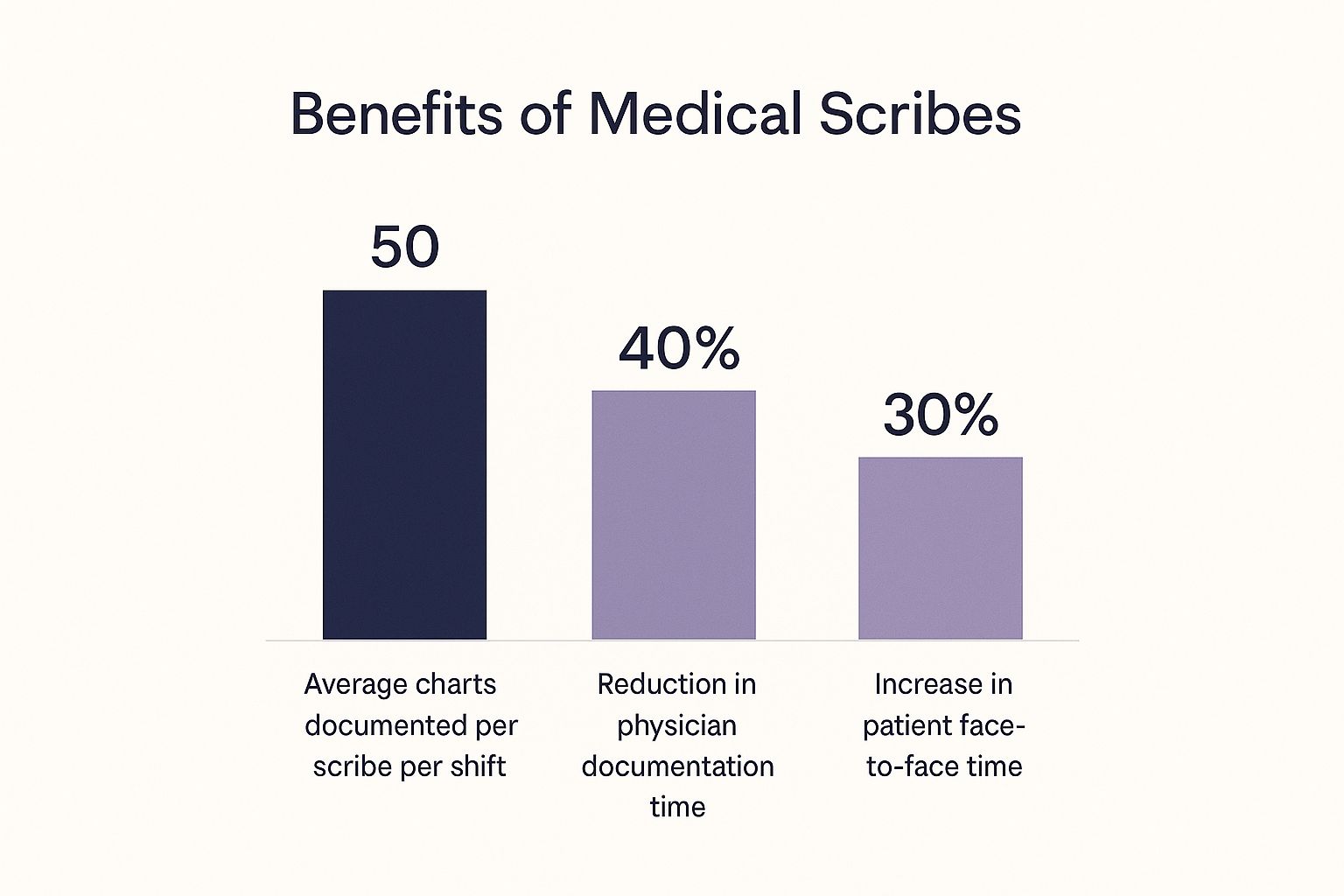The Real Story Behind Hospital Scribes Today

Step into the bustling world of a modern hospital, and you're likely to see doctors working alongside medical scribes. These aren't simply note-takers; they're trained professionals changing how healthcare is delivered. Hospital scribes do much more than just record information – they're essential team members, improving workflows and patient interactions. They are the key to accurate and efficient documentation, allowing physicians to concentrate on what truly matters: the patient.
This shift in healthcare comes from a significant challenge: the increasing demands of Electronic Health Records (EHRs). Doctors spend hours inputting data, time they could be spending with patients. Having a scribe eases this burden, letting doctors focus on direct patient care, building relationships, and providing more attentive service. This not only improves the patient experience but also physician well-being, lessening the chance of burnout.
Picture a busy emergency room. A physician rushes between patients. Instead of stopping to enter information into a computer, the physician dictates observations and instructions to the scribe, who documents everything in real-time. This allows the physician to move quickly to the next patient, keeping the flow of care going and reducing wait times.
Scribes can also anticipate physician needs, gathering information beforehand and preparing necessary documents. This further streamlines the workflow. This efficiency leads to real improvements: increased patient throughput, more accurate coding, and better financial results for the hospital.
The Evolving Role of Scribes in Hospitals
However, things are changing. The role of scribes is rapidly evolving, moving from a human-centric approach to one increasingly driven by AI, especially as we approach 2025. Traditionally, medical scribes significantly reduced documentation burdens on clinicians. But the arrival of AI-powered scribes is shifting this dynamic. Learn more about the future of AI scribes: AI Scribes and Virtual Care. This combination of human expertise and AI efficiency is set to reshape how medical documentation is done in the future.
Inside the Hospital: How Scribes Transform Daily Workflows
Ever wondered what a medical scribe's 12-hour shift in a bustling hospital is really like? It's a constant, carefully choreographed interplay between documentation and patient care. Let's shadow a seasoned scribe for a day, experiencing everything from detailed morning rounds with specialists to the fast-paced energy of the emergency room, where accurate, real-time documentation is paramount.
A Day in the Life: Scribes in Action
Imagine a complex case arriving in the ER. The physician, after examining the patient, quickly dictates their observations and treatment plan. The scribe, acting as a second brain, captures every single detail in real time. This ensures nothing gets lost in the whirlwind of activity and allows the physician to stay completely focused on the patient, offering comfort and building trust through uninterrupted eye contact.
Later, during rounds, the scribe anticipates the physician's needs, preparing notes beforehand with relevant patient history and test results. This prep work eliminates the need for the physician to wade through charts, saving precious minutes and streamlining the entire workflow.
Efficiency and Accuracy: The Scribe Advantage
Hospital scribes develop sophisticated organizational systems to manage demanding workloads. They become experts at prioritizing documentation, recognizing which information needs immediate attention and what can be handled later. This skillful information management is key to keeping the whole department running like a well-oiled machine.
Experienced scribes become fluent in navigating complex EMR systems anticipating physician preferences, and maintaining accuracy even during the busiest shifts. Their ability to handle interruptions, juggle multiple patients, and document everything precisely is essential for the best possible patient outcomes.
To understand the impact of scribes more concretely, let's look at a comparison of clinical workflows with and without scribe support. The table below illustrates how scribes affect key efficiency metrics.
Traditional vs. Scribe-Supported Clinical Workflows
Comparison of time allocation and efficiency metrics between physicians working with and without scribe support
| Activity | Without Scribe (minutes) | With Scribe (minutes) | Time Saved (minutes) |
|---|---|---|---|
| Patient Intake | 15 | 5 | 10 |
| Physical Examination | 10 | 10 | 0 |
| Documentation | 20 | 5 | 15 |
| Ordering Tests/Procedures | 10 | 2 | 8 |
| Patient Consultation | 15 | 20 | -5 (Time gained for patient interaction) |
| Total Time per Patient | 70 | 42 | 28 |
As you can see, scribes free up significant time for physicians by taking over documentation responsibilities. This allows physicians to spend more time engaging with patients, leading to more thorough consultations and a stronger patient-physician relationship.

The infographic above visually represents the impact scribes have on key performance indicators. On average, scribes document 50 charts per shift. This translates to a 40% reduction in physician documentation time and a 30% increase in face-to-face time with patients. This boost in patient interaction allows for more comprehensive discussions, improved communication, and stronger patient relationships. For a deeper dive into effective communication in healthcare, explore our guide: Healthcare Communication Strategies. These benefits combine to create a more efficient and patient-centered healthcare experience.
AI Revolution: Technology Reshaping Medical Documentation

This screenshot from Fierce Healthcare highlights the growing role of technology, particularly AI, in healthcare. It's a visual cue that underscores how deeply intertwined technology is becoming with the delivery of modern medicine.
Imagine a doctor talking with a patient, and instead of furiously typing notes, they're fully present, listening intently. Behind the scenes, AI-powered scribes are silently capturing the conversation, converting spoken words into comprehensive medical records. This isn't science fiction; it's happening now, reshaping medical documentation as we know it.
AI-Powered Scribes: Augmenting Human Capabilities
These AI systems aren't designed to replace human scribes. Think of them as powerful assistants. AI algorithms are becoming incredibly adept at distinguishing between medical terminology and everyday conversation. They filter out irrelevant information, focusing on the clinically important details, organizing everything according to clinical guidelines and regulations.
This frees up human scribes to focus on the human aspects of care. Imagine a scribe noticing a patient's subtle discomfort, offering reassurance, and then coordinating follow-up care, all while the AI seamlessly documents the physician's diagnosis and treatment plan.
For example, an AI system could automatically populate a patient's medical history during the consultation. This allows the scribe to observe non-verbal cues and provide much-needed emotional support. The result? More accurate, complete medical records and a more patient-centered approach. Plus, the AI can catch potential errors or omissions in real-time, further improving accuracy and reducing medical errors.
Implementation Success Stories: Real-World Results
Hospitals at the forefront of healthcare are embracing these AI-augmented scribe programs. They’re showing us how human scribes and AI can work together, drastically improving efficiency without sacrificing the personal touch. Industry forecasts predict that roughly 30% of the healthcare market, including hospitals and clinics, will be using ambient AI scribes by the end of the year. Large academic health systems are expected to reach even higher adoption rates, between 40% and 50%. For a deeper dive into these trends, check out this article: The Future of AI Scribes. These early adopters are not only transforming their own workflows, they're setting the stage for widespread adoption across the industry. Their experiences offer invaluable lessons for other institutions eager to combine the irreplaceable value of human experience with the efficiency of AI. This powerful synergy leads to better patient outcomes and increased satisfaction.
The Business Case: Why Hospitals Invest in Scribe Programs
The world of healthcare documentation is getting increasingly complex. Physicians are under more pressure than ever. Hospitals are actively searching for solutions that can improve both efficiency and patient care. That's where medical scribes come in. They offer a compelling business case that really resonates with hospital administrators and CFOs. Investing in a scribe program isn't just another expense; it's a strategic investment with the potential for significant returns.
Boosting Revenue and Reducing Costs
Think of scribes as financial superheroes in disguise. They directly impact a hospital's bottom line by improving coding accuracy. More accurate coding means hospitals receive the correct reimbursement for their services, boosting revenue. Scribes also minimize documentation errors, which can lead to costly penalties and rejected claims.
Imagine a busy emergency room during peak hours. Physicians are rushing between patients, trying to keep up with documentation. Scribes alleviate this pressure by handling the documentation, allowing physicians to see more patients. This increased patient throughput translates directly into higher revenue.
Furthermore, let's talk about physician burnout. Burnout leads to lower productivity, increased absences, and eventually, higher turnover costs. Implementing a scribe program can be a powerful tool in combating burnout and retaining physicians. This saves hospitals the significant expense of recruiting and training new doctors. Interested in learning more about operational efficiency? Check out this resource: Improving Hospital Operational Efficiency. Addressing burnout not only benefits physicians but also protects the hospital's investment in its medical staff.
Measuring Success and ROI
How do we know if a scribe program is working? We can measure success in several ways. Key metrics include the number of patients seen per physician, the reduction in documentation time, and the improvement in coding accuracy. These metrics clearly demonstrate a program's effectiveness and justify continued investment to hospital boards.
Different hospitals might focus on different metrics. A community hospital might prioritize improved patient satisfaction scores. A large academic center might focus on increased research output now that physicians have more time. Specialty facilities might track the reduction in medical errors due to improved documentation.
To give you a sense of the market growth, by 2025, the global AI scribe market is estimated to be worth over $2 billion and is expanding rapidly. More and more healthcare institutions are looking for ways to reduce the administrative burden on providers. The medical transcription software market is also projected to grow significantly, from $2.92 billion in 2025 to $8.41 billion by 2032, at a CAGR of 16.3%. For a deeper dive into the future of medical scribing, discover more insights here. Tracking the right metrics helps hospitals demonstrate the tangible benefits of scribe programs and ensures their continued success.
Let's take a closer look at the financial impact. The table below provides a general overview of potential ROI. Keep in mind that these figures can vary significantly based on specific hospital circumstances and implementation strategies.
Hospital Scribe Program ROI Analysis
Financial impact metrics showing costs, benefits, and return on investment for different hospital sizes implementing scribe programs
| Hospital Size | Annual Investment | Physician Time Savings | Revenue Impact | ROI Timeline |
|---|---|---|---|---|
| Small (100 beds) | $250,000 | 15% | $400,000 | 18-24 Months |
| Medium (300 beds) | $750,000 | 20% | $1,200,000 | 12-18 Months |
| Large (500+ beds) | $1,250,000 | 25% | $2,000,000 | 9-12 Months |
As you can see, the potential ROI for a scribe program can be substantial, especially for larger hospitals. While the initial investment can seem significant, the increased revenue and cost savings often lead to a positive return within a reasonable timeframe. Careful planning and execution are essential for maximizing the benefits of a scribe program.
Implementation Reality: Learning From Hospital Leaders

Implementing a scribe program in a hospital isn't a simple plug-and-play operation. It's more like a complex home renovation project while you're still living in the house. Careful planning, minimizing disruptions, and managing everyone's expectations are critical for success.
Common Obstacles and Creative Solutions
One of the biggest challenges is physician buy-in. Some physicians may be hesitant, seeing scribes as an extra layer of complexity or a potential disruption to their established routines. One hospital cleverly addressed this by implementing a short shadowing period before the scribes officially joined the team. This allowed physicians to experience the benefits firsthand and have their concerns addressed directly.
Another hurdle is integrating scribes into the existing workflow. Imagine trying to add a new instrument to an orchestra mid-performance—it takes practice and coordination. One hospital developed a dedicated scribe training program specifically tailored to their Electronic Medical Record (EMR) system and hospital procedures. This ensured scribes were well-prepared and could seamlessly integrate into the team’s rhythm.
Technology integration can also be a stumbling block. Ensuring scribes have smooth access to the necessary systems and can navigate them effectively is crucial. Think of it like giving a new employee the right keycard and showing them around the building. One hospital simplified access by implementing a single sign-on system for scribes, reducing technical issues and streamlining the process.
Finally, budget overruns can throw a wrench into even the best-planned projects. Accurate cost projections and continuous monitoring are essential. One hospital proactively created a detailed cost-benefit analysis before implementation, outlining anticipated costs and potential Return on Investment (ROI). This transparency helped secure support from leadership and kept the program financially sound.
Pilot Programs: Flourishing vs. Failing
Why do some pilot programs blossom into system-wide initiatives while others wither on the vine? Successful programs often start small, focusing on a specific department or unit, like testing a new recipe before serving it to a large crowd. This allows for controlled testing and fine-tuning before broader implementation.
For instance, one hospital piloted their scribe program in the fast-paced environment of the emergency department. They diligently tracked key metrics like physician satisfaction, documentation time, and patient throughput. The positive results from this pilot provided strong justification for expanding the program to other departments.
Another crucial element is communication. Keeping all stakeholders informed throughout the process is paramount. Regular meetings, feedback sessions, and clear communication channels help address concerns, build consensus, and foster support.
Actionable Insights: Avoiding Costly Mistakes
Learning from the missteps of others can save valuable time and resources. One common mistake is underestimating the importance of scribe training. Investing in comprehensive training ensures scribes are proficient in their roles and can contribute effectively. Think of it as investing in the proper tools for a craftsman – it sets them up for success.
Another pitfall is overlooking patient privacy concerns. Hospitals must address these concerns head-on, ensuring patient consent and upholding confidentiality. Clear guidelines and protocols regarding patient interactions are vital for building trust and ensuring ethical practices. This not only safeguards patient privacy but also protects the hospital’s reputation.
By learning from the experiences of other hospital leaders, you can navigate the complexities of scribe implementation more effectively. Careful planning, open communication, and a focus on training and privacy are essential for establishing a successful and sustainable scribe program. This translates to improved physician satisfaction, better patient care, and a healthier bottom line.
Patient Impact: The Human Side of Hospital Scribes
At the heart of any healthcare improvement lies a fundamental question: how does it affect the patient? With hospital scribes, the answer is overwhelmingly positive. They boost not only patient satisfaction but also the overall quality of care. Let's explore how these professionals make a real difference.
Enhancing the Doctor-Patient Connection
Imagine visiting your doctor and they spend the entire appointment staring at a computer screen. It feels impersonal, right? Scribes alleviate this issue. By taking over documentation duties, they allow physicians to make genuine eye contact with patients, building a stronger rapport.
This shift leads to more attentive listening, more empathy, and a more personalized visit. For example, a physician can fully concentrate on a patient's worries, providing reassurance and understanding without the distraction of typing notes. This seemingly small change has a profound impact on the patient experience. This focus on the human element builds trust and deepens the doctor-patient relationship. To learn more about boosting patient satisfaction, take a look at our guide: How to Improve Patient Satisfaction Scores.
The Quiet Guardians of Patient Safety
Scribes contribute to patient safety in numerous ways. Their meticulous record-keeping minimizes errors. This accuracy is vital when patients move between departments or different healthcare providers.
Complete and consistent records ensure smooth continuity of care, reducing the chance of miscommunication and medical errors. This detailed documentation has a ripple effect, positively impacting diagnoses, treatment plans, and patient outcomes.
Addressing Ethical Considerations and Privacy
Adding another person to the private doctor-patient interaction naturally brings up important ethical considerations. How do we protect patient privacy and uphold confidentiality?
Hospitals address this by implementing clear protocols for consent and safeguarding personal information. Scribes receive thorough training on HIPAA regulations and the importance of discretion. Many hospitals also offer patients the choice to decline a scribe's presence, respecting their right to privacy.
Improving Care Through Continuous Documentation
Scribes play a crucial role in maintaining accurate and up-to-date patient records. They capture details in real time, ensuring that important information isn’t missed in the busy hospital setting.
This accurate documentation enables better decision-making by healthcare providers and facilitates clear communication among medical teams. This steady flow of information streamlines treatment plans, minimizes delays, and ultimately leads to more effective patient care. For example, a scribe can instantly document a physician's observations during a complex surgery, creating a thorough record of each step for future reference.
Building Your Hospital's Scribe Success Strategy
Imagine building a successful scribe program like constructing a new wing of your hospital. It can't just be plopped down haphazardly; it needs to integrate seamlessly with the existing structure to truly benefit the whole system. That's what we'll explore here: how to weave scribes into the fabric of your hospital.
Evaluating Your Current Documentation Challenges
Before bringing in scribes, it's essential to take stock of your current documentation procedures. Where are the inefficiencies? Think of it like a checkup for your hospital's paperwork. Are physicians bogged down with EHR data entry, spending more time clicking boxes than with patients? Are documentation errors impacting revenue or, even more critically, patient care? Pinpointing these problem areas will guide your scribe implementation strategy. For instance, if your emergency department is constantly battling long wait times, assigning scribes there first could make a world of difference.
Building Stakeholder Buy-In
Getting everyone on board – physicians, nurses, administrators – is crucial. Open communication is your most valuable tool. Clearly lay out the benefits of using scribes, addressing any concerns head-on. Emphasize the positive ripple effect on both physician well-being and the quality of patient care. A great way to foster support is to involve physicians in the scribe selection process. This gives them a sense of ownership and helps ensure a good fit.
Choosing the Right Scribe Model
Just as there’s no single cure-all in medicine, there’s no one-size-fits-all scribe solution. The ideal model depends on your hospital's unique needs and culture. Do you require in-person scribes, virtual scribes, or a hybrid approach? Factors like your patient population, budget, and existing technology infrastructure all play a role in this decision. A smaller hospital with a tighter budget, for example, might find a virtual scribe program more cost-effective.
Training and Workflow Integration
Once you’ve chosen your scribe model, invest in thorough training. Scribes need to be fluent in your EMR system, understand hospital protocols, and be attuned to the specific needs of your physicians. Think of it like onboarding any new team member – clear expectations and support are key. A gradual integration into your workflow is best. Starting with a pilot program in a specific department, like the often-hectic emergency room, allows for a controlled rollout. You can then gradually expand the program to inpatient floors as the initial kinks are worked out.
Measuring Success and Future-Proofing
How do you know your scribe program is making a difference? Establish clear metrics to track your progress. Monitor physician satisfaction, documentation time, coding accuracy, and patient throughput. These data points demonstrate the tangible value of your scribe program and provide justification for continued investment. Finally, as healthcare technology continues to advance, consider how AI-powered tools can complement your human scribes. This blend of human expertise and AI efficiency can further enhance documentation accuracy and create even smoother workflows.
Ready to lighten the administrative load and elevate patient care? Simbie AI offers a voice-based artificial intelligence platform that automates routine tasks, optimizes patient interactions, and frees up your staff to focus on what truly matters. Learn how Simbie AI can transform your practice: https://www.simbie.ai

